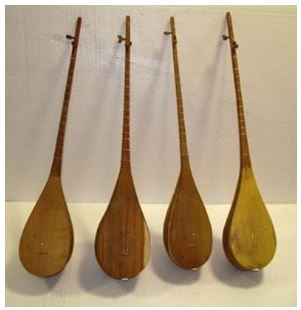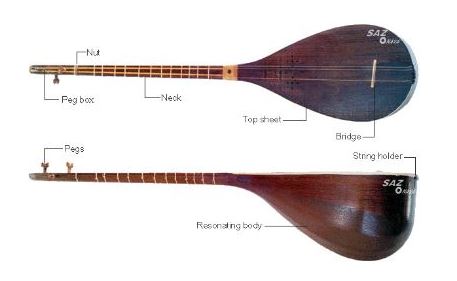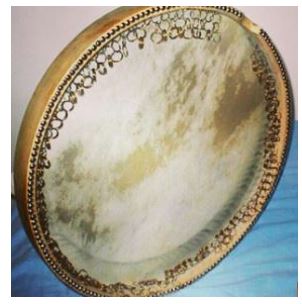A wide variety of instruments, each having a distinct cultural and historical significance, enhance the musical traditions of the Middle East. Persian music is often lyrical and expressive, with the haunting melodies of the dotar of Khorasan, a pear-shaped long-necked lute with a mesmerizing, melancholic resonance. The tanbur, a sacred instrument with three steel strings similar to the dotar, is played in Kurdistan’s rough terrain. The daf, on the other hand, is a hard wood drum with a circular frame and metal chains inside. It is 53 centimeters in length and covered in fish, cow, or goat skin (Week 5 slides). Encouraging a profound sense of connection and spirituality, its hypnotic beats form the basis of religious rituals and traditional dances. Collectively, we learned that these instruments are a vital component of the lively musical mosaic that embodies the Middle East, honoring the region’s diverse cultural and historical backgrounds (Ameneh, 1995).

Fig 1. Dotar of Khorasan

Fig 2. Tanbur of Kurdistan

Fig 3. Daf
When one listens to the two dotar compositions, “Hajigholagh” and “Allah Mazar,” one finds that the music begins slowly and then smoothly transitions into a fast-paced, repetitive rhythm. As the song’s recurring rhythm persists, the music primarily consists of the same chords rendered repeatedly with minor stylistic changes that provide an additional perspective to te song for the listener. These pieces feature a variety of beats and tones, with a change in tempo roughly every 20 seconds. Their overall sense of rhythm is enhanced by the notes on the lower end of the musical spectrum being consistently played in a similar way. Despite these songs’ repeated notes, the different thoughts that are incorporated in them keep them from growing monotonous and boring to listen to. The music never slows down and keeps up a constant aggressive tempo that can capture attention of audiences.
Being a two-string instrument, the dotar is unable to create a variety of beats and sounds. The songs’ speed therefore increases significantly toward the end with the repetitive beats. Near the end of the track, the audience will experience an upsurge of enthusiasm due to the novel style that the music has acquired due to the rise in speed. To compensate for the absence of different beats in dotar music, the musician should be able to play melodies quickly enough to maintain the music’s appeal. The sound quality of the music is crisp, with every note audible during performance. Within the confines of the traditional songs, individual expression is possible due to the improvisational nature of the dotar music styles.
Listening to “Avazi” and “Jubilation” Kurdistan music by Ali Akbar Moradi, you hear jubilant music showcasing distinctive melodic structures perhaps reflecting their cultural heritage. The songs start almost the same with the playing of the tanbur instrument in a moderate tempo joined with other instruments as the song gains momentum. They then proceed to a repetitive monotonous beat played in a jubilation format. As one listens to these songs you can gauge their origin since the music sounds unique. The repetitive rhythms then become enjoyable as it nears climax with a constant beat helping reduce monotony and hence the boring nature of the song not contained.
Like other Eastern music, Kurdish music is modal and monophonic. It is also heterophonic, though, since the same melody is played on several instruments with different ranges of pitch, colors, and ornamentation levels. The foundation of a type of Kurdish music is a collection of tunes with distinct, structured rhythms called gourani, or closed. Kurdish tabur music tends to be more spiritual and transcendental in nature (“Kurdistan”). The tanbur’s resonance and the repetitiveness of the melodies combine to produce a hypnotic, trance-like atmosphere that inspires deep reflection and connection in listeners.
Works Cited
“Kurdistan.” Kereshmeh Records –, www.kereshmeh.com/view_article.php?id=kurdistan.
“Avazi” Ali Akbar Moradi, https://open.spotify.com/album/6wD4EeV0hq2vq2it32qDst
“Jubilation” Ali Akbar Moradi,https://open.spotify.com/album/6wD4EeV0hq2vq2it32qDst
“Hajigholagh” Haj Ghorban Soleimani, https://open.spotify.com/artist/78MhoDVx9jvRyrxeI7p855
“Allah Mazar,” Haj Ghorban Soleimani,
Ameneh Yousefzadeh, August 1995, http://www.kereshmeh.com/view_instrument.php?id=Dotar
Ameneh Yousefzadeh, August 1995, http://kereshmeh.com/view_article.php?id=khorasan
Ameneh Yousefzadeh, August 1995,
http://www.kereshmeh.com/view_instrument.php?id=Tanbur
Week 5 Slides – Music of Khorassan, Dotar, Ghoshmeh, Music of Kurdistan, Tanbur, Daf.” MUS 111 WORLD MUSICAL TRADITIONS PERSIAN/IRANIAN MUSIC , Lecture.
Delivering a high-quality product at a reasonable price is not enough anymore.
That’s why we have developed 5 beneficial guarantees that will make your experience with our service enjoyable, easy, and safe.
You have to be 100% sure of the quality of your product to give a money-back guarantee. This describes us perfectly. Make sure that this guarantee is totally transparent.
Read moreEach paper is composed from scratch, according to your instructions. It is then checked by our plagiarism-detection software. There is no gap where plagiarism could squeeze in.
Read moreThanks to our free revisions, there is no way for you to be unsatisfied. We will work on your paper until you are completely happy with the result.
Read moreYour email is safe, as we store it according to international data protection rules. Your bank details are secure, as we use only reliable payment systems.
Read moreBy sending us your money, you buy the service we provide. Check out our terms and conditions if you prefer business talks to be laid out in official language.
Read more